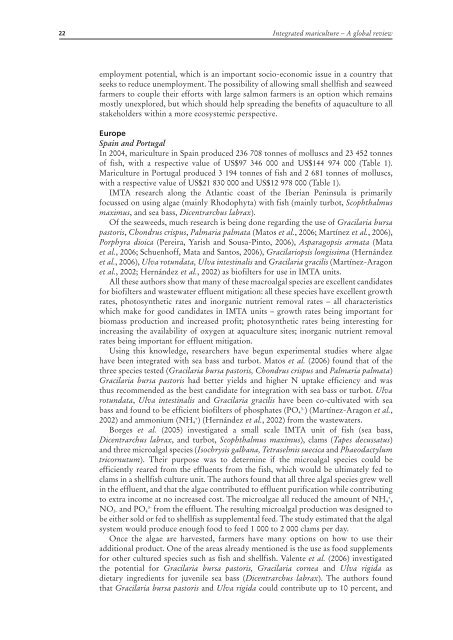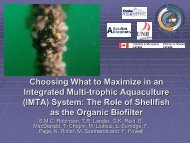Integrated multi-trophic aquaculture (IMTA) in marine temperate waters
Integrated multi-trophic aquaculture (IMTA) in marine temperate waters
Integrated multi-trophic aquaculture (IMTA) in marine temperate waters
Create successful ePaper yourself
Turn your PDF publications into a flip-book with our unique Google optimized e-Paper software.
22<br />
<strong>Integrated</strong> mariculture – A global review<br />
employment potential, which is an important socio-economic issue <strong>in</strong> a country that<br />
seeks to reduce unemployment. The possibility of allow<strong>in</strong>g small shellfish and seaweed<br />
farmers to couple their efforts with large salmon farmers is an option which rema<strong>in</strong>s<br />
mostly unexplored, but which should help spread<strong>in</strong>g the benefits of <strong>aquaculture</strong> to all<br />
stakeholders with<strong>in</strong> a more ecosystemic perspective.<br />
Europe<br />
Spa<strong>in</strong> and Portugal<br />
In 2004, mariculture <strong>in</strong> Spa<strong>in</strong> produced 236 708 tonnes of molluscs and 23 452 tonnes<br />
of fish, with a respective value of US$97 346 000 and US$144 974 000 (Table 1).<br />
Mariculture <strong>in</strong> Portugal produced 3 194 tonnes of fish and 2 681 tonnes of molluscs,<br />
with a respective value of US$21 830 000 and US$12 978 000 (Table 1).<br />
<strong>IMTA</strong> research along the Atlantic coast of the Iberian Pen<strong>in</strong>sula is primarily<br />
focussed on us<strong>in</strong>g algae (ma<strong>in</strong>ly Rhodophyta) with fish (ma<strong>in</strong>ly turbot, Scophthalmus<br />
maximus, and sea bass, Dicentrarchus labrax).<br />
Of the seaweeds, much research is be<strong>in</strong>g done regard<strong>in</strong>g the use of Gracilaria bursa<br />
pastoris, Chondrus crispus, Palmaria palmata (Matos et al., 2006; Martínez et al., 2006),<br />
Porphyra dioica (Pereira, Yarish and Sousa-P<strong>in</strong>to, 2006), Asparagopsis armata (Mata<br />
et al., 2006; Schuenhoff, Mata and Santos, 2006), Gracilariopsis longissima (Hernández<br />
et al., 2006), Ulva rotundata, Ulva <strong>in</strong>test<strong>in</strong>alis and Gracilaria gracilis (Martínez-Aragon<br />
et al., 2002; Hernández et al., 2002) as biofilters for use <strong>in</strong> <strong>IMTA</strong> units.<br />
All these authors show that many of these macroalgal species are excellent candidates<br />
for biofilters and wastewater effluent mitigation: all these species have excellent growth<br />
rates, photosynthetic rates and <strong>in</strong>organic nutrient removal rates – all characteristics<br />
which make for good candidates <strong>in</strong> <strong>IMTA</strong> units – growth rates be<strong>in</strong>g important for<br />
biomass production and <strong>in</strong>creased profit; photosynthetic rates be<strong>in</strong>g <strong>in</strong>terest<strong>in</strong>g for<br />
<strong>in</strong>creas<strong>in</strong>g the availability of oxygen at <strong>aquaculture</strong> sites; <strong>in</strong>organic nutrient removal<br />
rates be<strong>in</strong>g important for effluent mitigation.<br />
Us<strong>in</strong>g this knowledge, researchers have begun experimental studies where algae<br />
have been <strong>in</strong>tegrated with sea bass and turbot. Matos et al. (2006) found that of the<br />
three species tested (Gracilaria bursa pastoris, Chondrus crispus and Palmaria palmata)<br />
Gracilaria bursa pastoris had better yields and higher N uptake efficiency and was<br />
thus recommended as the best candidate for <strong>in</strong>tegration with sea bass or turbot. Ulva<br />
rotundata, Ulva <strong>in</strong>test<strong>in</strong>alis and Gracilaria gracilis have been co-cultivated with sea<br />
bass and found to be efficient biofilters of phosphates (PO 4 3- ) (Martínez-Aragon et al.,<br />
2002) and ammonium (NH 4 + ) (Hernández et al., 2002) from the waste<strong>waters</strong>.<br />
Borges et al. (2005) <strong>in</strong>vestigated a small scale <strong>IMTA</strong> unit of fish (sea bass,<br />
Dicentrarchus labrax, and turbot, Scophthalmus maximus), clams (Tapes decussatus)<br />
and three microalgal species (Isochrysis galbana, Tetraselmis suecica and Phaeodactylum<br />
tricornutum). Their purpose was to determ<strong>in</strong>e if the microalgal species could be<br />
efficiently reared from the effluents from the fish, which would be ultimately fed to<br />
clams <strong>in</strong> a shellfish culture unit. The authors found that all three algal species grew well<br />
<strong>in</strong> the effluent, and that the algae contributed to effluent purification while contribut<strong>in</strong>g<br />
to extra <strong>in</strong>come at no <strong>in</strong>creased cost. The microalgae all reduced the amount of NH 4 + ,<br />
NO 3- and PO 4 3- from the effluent. The result<strong>in</strong>g microalgal production was designed to<br />
be either sold or fed to shellfish as supplemental feed. The study estimated that the algal<br />
system would produce enough food to feed 1 000 to 2 000 clams per day.<br />
Once the algae are harvested, farmers have many options on how to use their<br />
additional product. One of the areas already mentioned is the use as food supplements<br />
for other cultured species such as fish and shellfish. Valente et al. (2006) <strong>in</strong>vestigated<br />
the potential for Gracilaria bursa pastoris, Gracilaria cornea and Ulva rigida as<br />
dietary <strong>in</strong>gredients for juvenile sea bass (Dicentrarchus labrax). The authors found<br />
that Gracilaria bursa pastoris and Ulva rigida could contribute up to 10 percent, and



